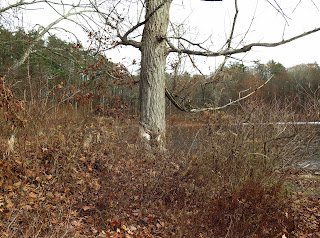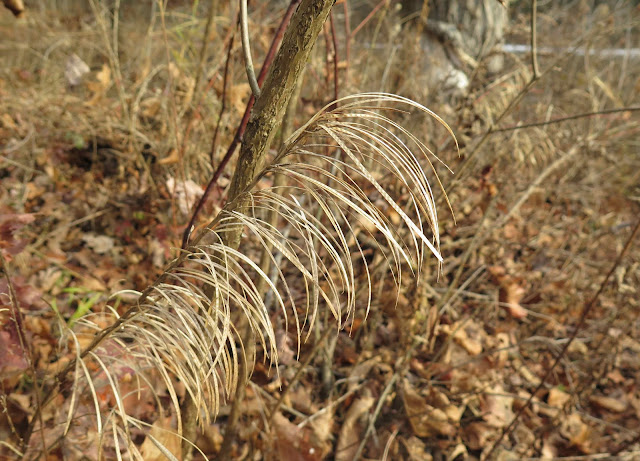Due to a recent painful bout of ocular rosacea, I've neglected both cold-weather outdoor walks and extended computer use for a while. And my blogging has been on hold. But one rather dark and not-too-cold day last week, I did venture up to Moreau Lake State Park. I had not been able to explore the shore of the lake all summer, because of high water levels, but now the sandy and pebbly sections of shore have emerged and are beckoning my return. I particularly wanted to walk the shore of a cove that is home to some of our state's rarest plants. How had these plants fared from being flooded all summer?
At first glance, the vegetation appeared to be shriveled beyond recognition, but I knew very well that certain plant remnants do persist in a recognizable state all year. And I also knew that many of them clustered about the base of a certain shoreline Cottonwood tree.
Sure enough, these puffy gray balls that once held the seeds of Whorled Mountain Mint (Pycnanthemum verticillatum var. verticillatum) were easily seen, still standing on stems that held them above the surrounding brown vegetation. And because the summer's high water had not reached this far up the shore, a healthy population of a dozen or so plants remained intact. This plant is one of New York's rarest species, rated as Endangered, so I always feel reassured to find it still surviving here on the shore of Moreau Lake.
Sadly, though, the population of Whorled Mountain Mint has declined substantially since I first discovered it here 10 years ago, and a state rare-plant monitor later assessed its numbers along this cove's shoreline to be more than 270 healthy specimens. Because Moreau Lake is a kettle lake, dependent for its water mainly on rainfall and snowmelt, its water levels rise and fall substantially from year to year. Recent years of high water have eliminated much of this rare plant's growing space, but at least enough plants remain intact to provide a seedbank for continued survival along this particular cove's shoreline. We have not found other populations of Whorled Mountain Mint anywhere else around the lake, or anywhere else in Saratoga County.
A second rare plant that shares this same shoreline is the Mustard-family plant called Green Rockcress (Borodinia missouriensis). Because this plant possesses distinctive arching seedpods that persist through the winter, it is easy to spot this time of year, and indeed, I saw dozens of persisting plants along this cove, both out on the sand and also higher up on the forested banks. Although Green Rockcress is rated as a Threatened species in New York, several hundred specimens have been recorded at Moreau Lake State Park, at several locations around the park as well as out here on the cove. We have no reason to think that this species is threatened within this park.
I searched and searched among the pebbles and found no recognizable remnants of Small-flowered Dwarf Bulrush. I suppose these wispy brown threads could have been what I was looking for, but I definitely was not certain.
Despite not finding any recognizable remnants of Cyperus subsquarrosus today, I saw lots of other tiny green plants snuggled in among the stones. And I loved looking at the colorful mix of pebbles that cover this shore.
And as lovely as those pebbles looked when dry, just see how gorgeous some others were when covered by an inch or so of clear water, with golden ribbons of sunlight rippling across them. I was grateful that a break in the clouds brought not only some shoulder-warming rays on this otherwise cold day, but also this transforming brilliance to the shore of Moreau Lake.










ReplyDeleteHappy to see you back in (blogging) action ! That walk always yields treasures, and not just plant life (those colorful pebbles !)
Today I learned that the Green Rock Cress also grows along the cove shore, not just up by the roadway - huzzah
I would have gone home with my pockets full of pebbles. I simply can't not pick them up....
ReplyDeleteAnd isn't it wonderful when the water recedes and we can walk, willy-nilly, where it was! The river has fallen away now, and it is possible to walk the bare area between it and the brushy shoreline. Still a bit muddy though. Wishing you the best of holiday seasons from all of us here at Northview.
I always wonder how many other populations of rare plants exist that have never been found by a knowledgeable botanist. An old friend who was a superb amateur botanist found two populations of small whorled pogonia that he would not submit to the Pennsylvania Natural Diversity Inventory for fear that the plants would wind up in a museum herbarium as happened with a Small's twayblade several years before. He took several of us, by a convoluted circuitous route, to photograph them and took the exact location to the grave with him (there's no way I could ever have found my way back to that spot in otherwise unremarkable oak forests with no landmarks or distinguishing features).
ReplyDelete